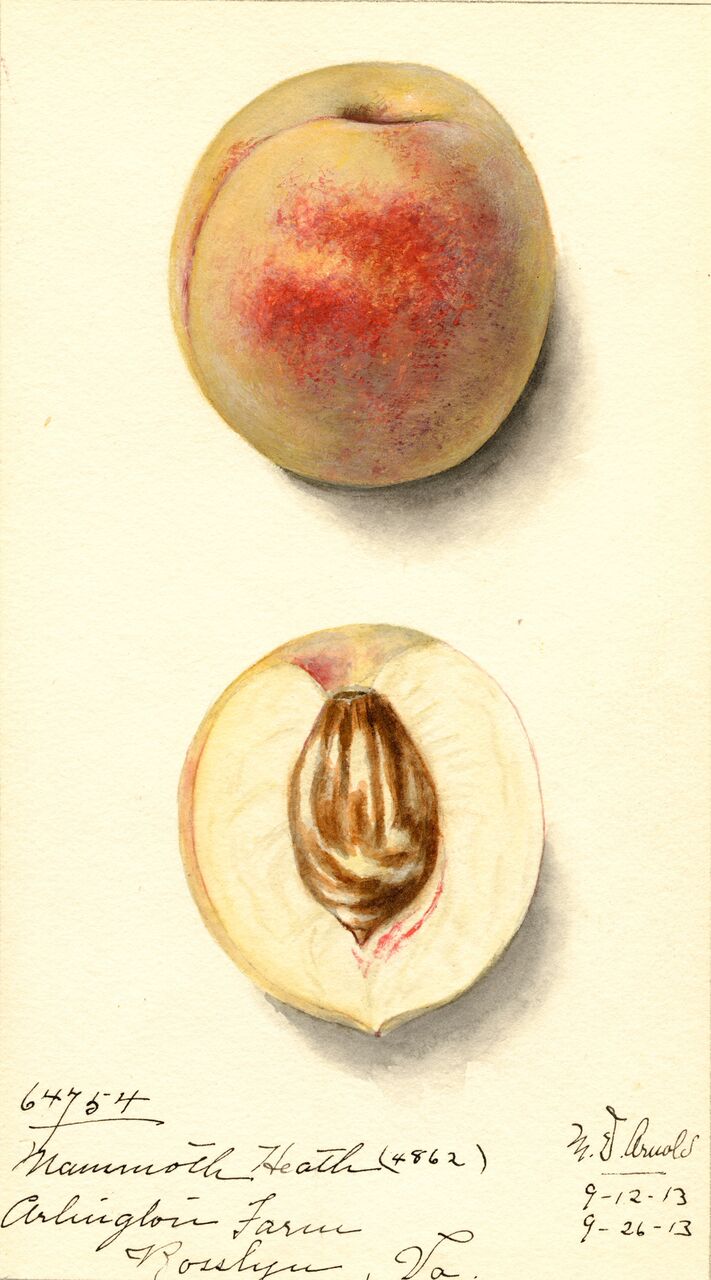 HEATH CLING
HEATH CLING
Retained in the USDA germ plasm collection—PI 673629. http://www.ars-grin.gov/cgi-bin/npgs/acc/display.pl?1564479 . A white cling peach of great antiquity, it was brought to North American from Europe during the colonial era. Next to the Blood Cling, or Indian Blood Peach, it is the oldest named variety in continuous cultivation in the United States. Its virtues—long shelf life, late season, and its “sweet, rich, vinous taste”—outweighed its liabilities—modest productivity, the strong adhesion of the meat to the stone. From the first it was employed in cooked peach dishes and in canning much more frequently than being eaten fresh. The fruit were 2 ¼ inches in diameter, oval, tending to angular in its lower hemisphere.
"This very fine clingstone peach is generally esteemed the finest in our country; the original stone was brought by the late Mr. Daniel Heath from the Mediterranean: it has ever since been propagated from the stone in Maryland, where I have seen it in great abundance and high perfection, as a natural fruit, in September and Octomber; it is usually propagated in this and the adjoining States by inoculation; I have for some years raised them from stones brought from Maryland. It is a very large friut; of a form rather oblong, and uniformly terminating in a point at the head--the flesh is singularly rich, tender, melting, and juicy--the stone frequently opens, disclosing the kernel--the skin is a rich cream-coloured white, sometimes with a faint blush, but the finest peaches are entirely white--the juice is so abundant, as to make it difficult to eat this peach without injury to the clothes; the leaf is luxuriant and smooth at the edge, the tree vigorous, hardy and long-lived, compared with other trees--the fruit ripens in September, lasts through the month of October, and is frequently eaten in high perfection in November: it is of all peaches, when not too ripe, and most admired when preserved in sugar, or in brandy." William Coxe, Cultivation of Fruit Trees (Philadelphia 1817).
Nursuries that offered Heath Cling in the South prior to 1920:
Alabama Nursery Company, Huntsville AL 1900. D. Beatie’s Atlanta Nursery, 1891, 1895. F. Hillenmeyer’s Bluegrass Nursery, Lexington, KY 1891, 1897, 1909. W. Craft’s Cedar Grover Nursery, Salem, NC 1893. Cherokee Nursery, Waycross, GA 1893. Clingman Nursery & Orchard, Kiethville LA 1908. Colmant Nurseries, West End AL 1904. Comal Springs Nursery, New Braunfels TX 1903. Delaware Nurseries, Milford DE 1910. Chattanooga Nurseries Dixie Garden Handbook, Chattanooga TN 1907. S. Downer & Sons Nursery, Fairview KY 1870. J. Berckmans Fruitland Nurseries, Augusta GA 1877. William Summer Pomaria Nursery, Pomaria SC 1856. Franklin Davis Richmond Nurseries, Richmond VA 1869. Van Lindley Nursery, Pomona NC 1915. Charles Wright’s Peachland Nurseries, Seaford DE 1891. Munson Hill Nurseries & Greenhouses, Falls Church VA 1908. Forked Deer Nursery, Curve TN 1890. T. Hood Old Dominion Nursery, Richmond VA 1894. Mallinckrodt Nursery, St. Charles MO 1891. L. Taber Glen St. Mary Nursery, Glen St. Mary FL 1894.
Image: U.S. Department of Agriculture Pomological Watercolor Collection. Rare and Special Collections, National Agricultural Library, Beltsville, MD 20705, Mary Arnold, 1913.
David S Shields